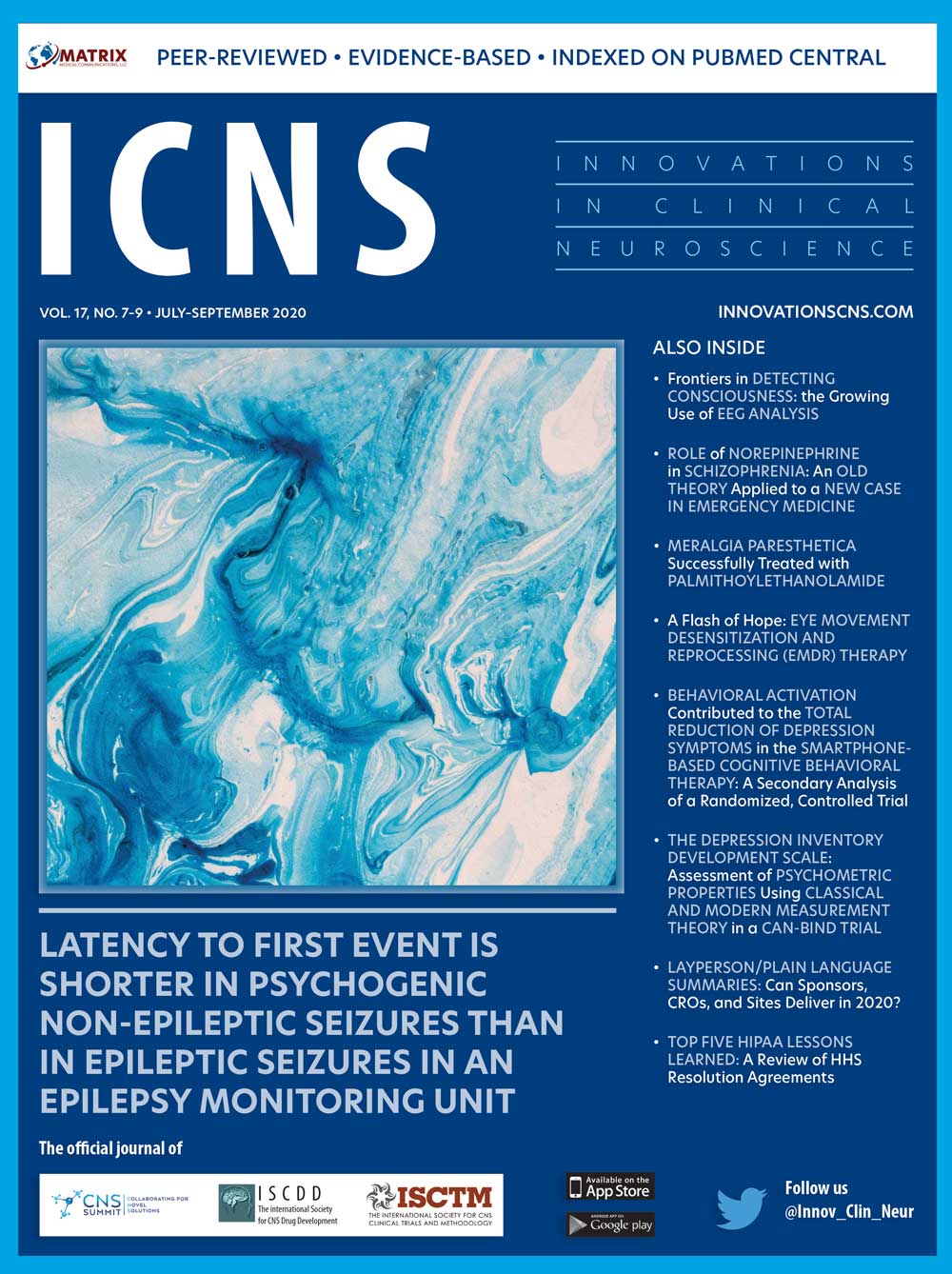 Dear Colleagues:
Dear Colleagues:
Welcome to the July–September 2020 edition of Innovations in Clinical Neuroscience (ICNS). For 2020’s third quarterly issue of ICNS, we start with two letters to the editor. First, Frontiers in Detecting Consciousness: The Growing Use of EEG Analysis highlights the growing scientific evidence supporting the use of electroencephalogram (EEG) and multivariate analysis as a means to better identify states of awareness in patients with consciousness disorders. Next, in Role of Norepinephrine in Schizophrenia: An Old-fashioned but New Story from Emergency Medicine, Dr. Nagamine describes a case of 71-year-old female patient with chronic paranoid schizophrenia who developed symptoms of delusion and hallucination following treatment with norepinephrine for septic shock.
Following, in Meralgia Paresthetica Successfully Treated with Palmithoylethanolamide, the authors discuss the case of a 28-year-old patient with posttraumatic meralgia paresthetica, a mononeuropathy with paresthesia and numbness in the anterolateral surface of the thigh, who was treated with 1200mg/day of palmithoylethanolamide, which is primarily used as chronic pelvic pain and compressive neuropathies therapy. This case report also evaluated whether palmithoylethanolamide provide protection against neuropathic pain and serve as a treatment option for the above condition.
Using thorough explanations and composite case vignettes of fundamental phases and research, authors describe the success of the psychotherapy treatment, eye movement desensitization and reprocessing in this issue’s Psychotherapy Rounds. A Flash of Hope: Eye Movement Desensitization and Reprocessing highlights that this type of therapy provides patients with opportunities to alter their responses and own evaluation to traumatic events through bilateral stimulation in conjunction with conversations relating to traumatic memories and negative feelings.
Next, this secondary analysis, Behavioral Therapy: A Secondary Analysis of a Randomized, Controlled Trial, evaluates the effects of cognitive behavior therapy (CBT) and potential improvement depression symptoms in 164 participants using linear regression, the Beck Depression Inventory-II, and K6. According to researchers, CBT included self-monitoring, behavioral activation, and cognitive restructuring via smartphone, and that behavioral activation was the primary factor that contributed to the reduction of depressive symptoms.
Then, to analyze latency to first event in 111 participants with psychogenic nonepileptic seizures compared with epileptic seizures through an epilepsy monitoring unit, Sagi et al constructed a “retrospective chart review” in Latency to First Event is Shorter in Psychogenic Non-epileptic Seizures Than in Epileptic Seizures in an Epilepsy Monitoring Unit. The review consists of patients admitted to the researcher’s epilepsy monitoring unit with the above conditions, recording their demographics, length of stay, seizure frequency, and time from admission.
Following this is original research from Vaccarino et al that was part of multisite, open-label study by the Canadian Biomarker Integration Network. In The Depression Inventory Development Scale: Assessment of Psychometric Properties Using Classical and Modern Measurement Theory in a CAN-BIND Trial, the authors evaluate the current Depression Inventory Development (DID) and its item bank by utilizing Classical Test Theory, Item Response Theory, and Rasch Measurement Theory to ensure DID’s rating scale for major depressive disorder properly mirrors present diagnostic criteria and ideas of depression. Throughout the study, researchers analyze the DID items that needed to be removed, modified, or facilitated for optimal program outcomes.
Next, in Layperson/Plain Language Summaries: Can Sponsors, CROs, and Sites Deliver in 2020?, the authors review the benefits, complications, and advocacy of the implementation of layperson/plain language summaries in clinical trials and for related data. Also discussed is the idea that incorporating layperson/plain language summaries can provide the pharmaceutical industry with excellent opportunities, as clinical trial participants often express interest in wanting to understand results and conditions of studies.
Finally, we wrap up the issue with the Risk Management column, where Justin Pope, an Associate Risk Manager at Professional Risk Management Services, offers thorough lessons learned after reviewing the United States Department of Health and Human Services’ Office of Civil Rights case resolutions agreements. Top Five HIPAA Lessons Learned: A Review of HHS Resolution Agreements not only contains information on civil enforcement cases, but additional resources per every notable enforcement resolution section as well.
As always, we hope you enjoy this issue of ICNS, and we look forward to receiving your feedback and submissions.
Sincerely
Amir Kalali, MD
Editor, Innovations in Clinical Neuroscience





